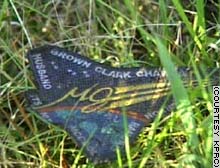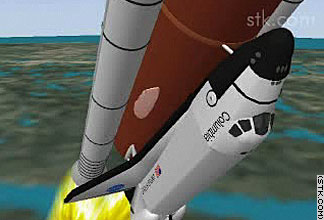





This patch was found on the side of a road in Texas (cnn.com).
WHAT CAUSED THE
COLUMBIA ACCIDENT?
When an accident occurs in space, determining the causes can be a daunting task. For one thing, debris can be scattered across thousands of miles or, worse, in orbit where it is nearly unrecoverable. In the case of Columbia, the debris field did span hundreds of miles of the southern United States, but NASA has managed to piece together an accurate description of what experts believe to be the cause of the shuttle's breakup.
At first, all NASA had was telemetry from the shuttle and video footage of the mission. It was clear that something had caused the shuttle to veer wildly off course, upsetting its aerodynamics and causing the heat and stress of reentry to break the shuttle into pieces. But why the shuttle had gone off course was another question.
The first clues came from footage of the launch, in which a piece of foam was seen flying away from the external tank and impacting the left wing of the orbiter. The footage was seen during the mission, but flight controllers believed that such a small piece of foam, with such negligible mass, could not have harmed the shuttle.

www.cnn.com
A piece of foam was seen falling fromthe external tank and striking the left wing of the orbiter during launch (light pink = foam) .
Once the foam was suspect, however, studies revealed that at the angle and speed that the foam was travelling when it hit the orbiter's wing, it could very easily have broken through the ceramic heat tiles on the leading edge of the wing. An experiment showed that the foam could have created a hole nearly ten inches in diameter.
Telemetry from the landing showed that the orbiter had veered sharply to the left, which would correspond with an increase in drag on the left side of the orbiter. Unknown to anyone on Columbia or in mission control, the orbiter's autopilot had been working against that drag for several minutes. Commander Rick Husband had tried to correct the flawed motion (he switched to manual control of the spacecraft) but had been unable to bring the orbiter back into line. Going over 10,000 mph, Husband lost control of the space craft.
Data also showed abnormally high temperatures in the left landing gear and areas around it. The temperatures experienced along the leading edge of the wing during reentry are far higher than those needed to melt the stuctural supports inside the wing of the shuttle (in the case of Columbia, they probably exceeded 5000 degrees Farenheit), therefore a hole in the wing would have compromised the integrity of the wing structure itself by melting critical components. The temperature readings supported the hypothesis that there was a hole in the left wing.
Finally, low resolution images taken from Kirtland Air Force Base showed streaking behind the left wing and a smudged area on the leading edge, which also contributed to the idea that there was at least some damage to the leading edge of the left wing.
http://spaceflight.nasa.gov/gallery/images/shuttle/sts-107/html/jsc2003e08089.html
The Columbia Accident Investigation Board was formed less than two hours after Loss of Signal from the orbiter. It included scientists, professors, generals, former astronauts, and directors of NASA offices. The board worked constantly to determine the cause (or causes) of the accident, collecting data from all around the country. Nearly 84,000 pieces of debris were collected, comprising about 38 percent of the total orbiter, and reassembled for analysis. The orbiter was recorded on video tape during most of its flight across the Western States. Columbia is shown shedding debris long before anyone on board or on the ground knew that anything was wrong. The CAIB did not release its report until August 2003.
In the report synopsis the Board states that, "the conclusion is that Columbia re-entered Earth's atmosphere with a pre-existing breach in the leading edge of its left wing in the vicinity of Reinforced Carbon-Carbon (RCC) panel 8. This breach [was] caused by the foam strike on ascent."
NASA has made many improvements in the checkout and development of the orbiter between flights, and the shuttle fleet is due to return to flight in 2005 with STS-114.
For the full CAIB report, see http://i.a.cnn.net/cnn/SPECIALS/2003/shuttle/CAIB.report.pdf . It is fairly redeable even to someone who is not well-versed in NASA lingo.
![]()